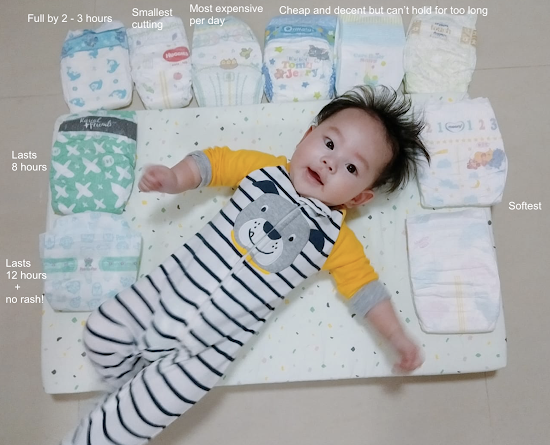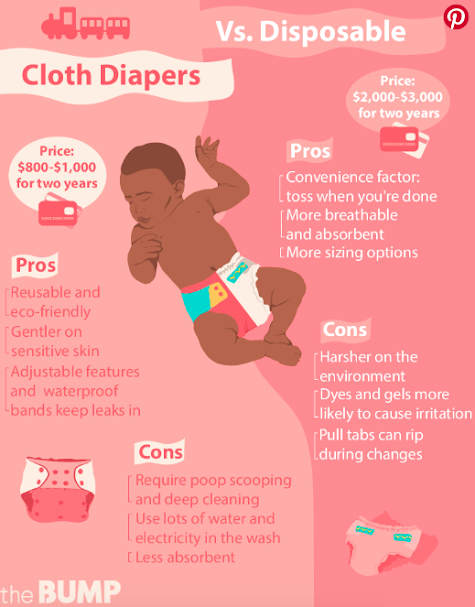Diapers 101 : Singapore Baby Diapers Guide 2024
Diapers 101 : Singapore Baby Diapers Guide 2024
1. Diapers Guide 101
2. Things to Consider When Picking Your Baby's Diaper
a) Pick Trustable BrandsMake sure you pink a trustable brand.
b) Diaper Features
c) Pick the right size

Avoid loading up on one size because your baby will require bigger-sized diapers every few months.
d) Skin Sensitivity
If your baby has sensitive skin like having rash because of diapers. You must look for hypoallergenic diapers. For example: Huggies Little Snugglers
3. How to Buy Baby Diapers
You can always start small. Try stockpiling no larger than size 1, just in case you don’t like the first brand you try.
Once you get a feel for fit, cost, brand, and size, go ahead and purchase more — up to an entire year’s worth or more of diapers. Keep in mind your own baby’s weight and rate of gain when planning. Never pay full price for diapers unless it’s an emergency (more on saving on diapers below).
Keep in mind that different brands may work better or worse for different babies, so be open to trying a few different diapers before you decide on the right ones for you. Sometimes a diaper that costs a little more is a better fit and works better, making it worth the extra money.
4. How Often Should You Change Your Baby's Diaper?
Change your newborn’s diaper every two to three hours, or as needed, according to experts. Because if the diaper isn’t changed frequently, the baby is at risk of developing skin rashes, infections, and a variety of other health problems.5. Diaper Rash
a. What is diaper rash
Diaper rash is a common type of inflamed skin (dermatitis) that appears on your baby’s bottom as a patchwork of bright red skin. Wet or infrequently changed diapers, skin sensitivity, and chafing are all common causes of diaper rash.b. What causes diaper rash
Diaper rash can be caused by a variety of factors. Diaper rash can occur when a new food is introduced into your child’s diet. It could also be the result of a new laundry detergent or bath product.Diaper rash can also occur when a child’s diaper is not changed frequently enough or caused by antibiotics your child is taking. Additionally, diapers or wipes that aren’t compatible with your child’s skin may be the reason of their diaper rash.
c. How to treat diaper rash
If the cause is a lack of hygiene, you should change your child’s diaper on a regular basis, making sure to thoroughly clean the baby’s bottom with a wipe or wet washcloth after each change. Then, apply a thin layer of diaper rash ointment to your baby’s bum to keep moisture at bay.
If your baby’s skin is really sensitive, it is best to use a diaper designed for sensitive skin. Change your child’s diaper frequently to avoid diaper rash in the future — moisture trapped on your child’s skin for an extended period of time can be quite harmful.
If it is due to a yeast infection. This will take a week or two of daily application of anti-fungal cream. Always make sure that your baby’s bottom is dry and clean while you’re treating them.
d. What to know about diaper rash
Diaper rash is frequently caused by a skin irritation caused by too much moisture in the diaper. The best way to solve this problem is to keep your baby’s bottom dry.For heavy wetter, do not change diapers too soon because if your baby sitting in a lot of moisture for long periods that can cause rashes.
It is also critical to avoid using any petroleum-based products on your baby’s sensitive skin because they cause too many dry spots, which can worsen the condition or cause more frequent flare-ups. Vaseline, Icy Hot, and Aquafor are examples of such products.
6. How Do I Keep My Diaper From Leaking?
a. Adjust the Diaper : Make sure the diaper is worn properly and tightly
b. Change your diapers right before bedtime to reduce bedtime leaking
c. Use Overnight Diapers : The usual disposable diaper is designed primarily for daytime use. It can last a few hours between changes but may not make it for a 10-12 hour stretch.
Overnight diapers are designed for the overnight hours. They’re constructed with extra absorbency and can keep the baby dry for up to 12 hours. They’re bulkier than normal diapers but are still comfortable and leave plenty of room for movement.
If you’re noticing that your baby is soaked every morning, switching to overnight diapers could be your first move.
d. Add a Diaper Liner : If overnight diapers are not enough, you can try adding an additional diaper liner inside the diaper for additional absorbency. Pay attention to where your baby is always leaking : the front or the back. Then add the liner on whichever side is always wet in the morning.
In this article, we will list down some of the best leak proof diapers available in Singapore.
7. Cloth Diapers vs Disposable Diapers
Cloth diapers, unlike disposable diapers, last significantly longer than one usage. When your child already using underwear, you can continue utilize cloth diapers for a variety of purposes. So it will save more money.
8. Other diaper tips
When you change your baby’s diaper, check to see if the fit is too small by looking for red marks where the elastic was fastened. You also want to make sure it’s not too big, which might lead to leakage.
The top of the diaper should fit right under the belly button, give your baby’s bum full coverage, and when fastened, the tabs should not overlap nor cause redness around the waist.
When using disposable diapers, make sure the cuffs around the leg openings are out, and not tucked in. Tucked in cuffs can cause leakage down the leg.
Regular disposable diapers are not designed to be worn while swimming. When submerged, these diapers will become water logged leaving them unable to absorb additional liquids and falling off your baby with the extra water weight.
For the health and safety of fellow swimmers (as well as to avoid an embarrassing situation) make sure that your little one is in a swim diaper in the pool, lake, or ocean.
While many diaper brands do not begin offering overnight diapers until size 3, you can purchase overnight diaper booster pads to place inside your child’s diaper if they’re sleeping long chunks of time and peeing through their diaper before they wake and aren’t yet ready for size 3.
That way you won’t have to decide between the equally awful choices of waking a sleeping baby to change their diaper or washing piles of urine soaked pajamas and bedding!
You may want to begin with only a small amount of diapers. As you get a feel for how quickly your child is growing and going through diapers, you’ll be able to better determine how many diapers in a particular size you’ll need.
If your baby has a penis, make sure it’s pointed downward into the new diaper when you are fastening it. This will help prevent urine from leaking up and out of the diaper. Pro tip: You’ll probably want to cover the penis when performing diaper changes, too!
Some people choose to use disposable diapers on their newborn because of the extra work in cleaning cloth diapers so frequently. However, for some newborns, cloth diapers can actually fit better. Since they are able to adjust more specifically around the legs, it can mean fewer leaks and wet clothing.
Regular disposable diapers are not biodegradable, since they include certain plastic and synthetic fibers. If you choose to use special compostable diapers, you can’t just add them to your normal compost pile! Make sure to follow directions for appropriate disposal.
If you think you’re going to have another child, go ahead and hang onto any extra diapers. Disposable diapers (open and unopened) have no expiration date. However, manufacturers do suggest using up diapers within 2 years of purchase though as the coloring, absorption, and elasticity may suffer over time.
Otherwise, it would be great to donate any extra diapers to a friend, church, food bank, child care center, or other nonprofit organization taking diaper donations versus throwing them out in a landfill.








Comments
Post a Comment